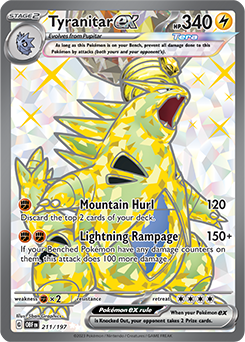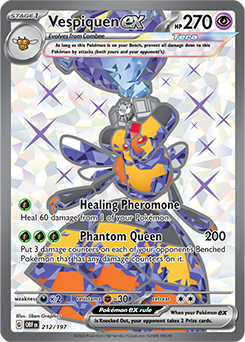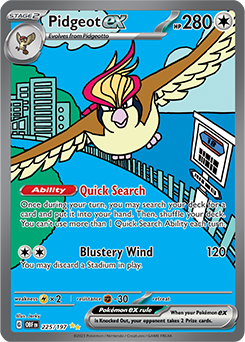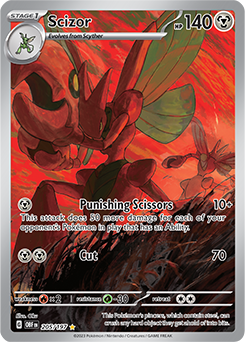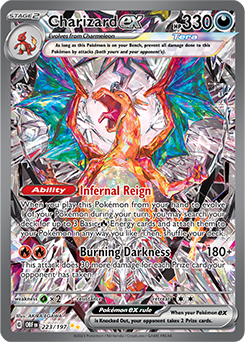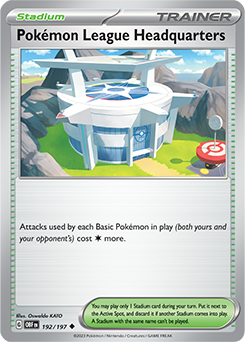Pokémon TCG: Scarlet & Violet—Obsidian Flames Top Competitive Cards
Scarlet & Violet—Obsidian Flames has only just launched, but players can already feel the heat rising at their local events. The expansion has plenty of cards that are either ready to enhance your deck or be the centerpiece of a new strategy. Get to know some of the hot cards that might be ready to smoke the competition in your next battle.
Tyranitar ex
A Trot to the Top
One of my favorite parts of Scarlet & Violet—Obsidian Flames is the prominence of Pokémon showing off different Tera Types, and Tyranitar ex is one of the most notable! While attacking with a Stage 2 Pokémon is no small task, Tyranitar ex is shaping up to be a potential threat in the Standard format. There’s no complex strategy here, just a Pokémon that packs a big punch. There are a lot of ways to get damage onto your own Benched Pokémon (e.g., Gapejaw Bog or perhaps Calamitous Snowy Mountain) to set up Lightning Rampage. And in the meantime, Mountain Hurl isn’t too shabby to get things started. While Pokémon VSTAR are beginning to yield to Pokémon ex in Standard, 280 damage will be a valuable number to hit as long as foes like Arceus VSTAR stick around. Conveniently, Tyranitar ex is a Choice Belt away from reaching that threshold!
With its attacks costing only 1 or 2 Energy, Tyranitar ex is in the rare spot of being able to dish out heavy damage without heavy Energy investment. When building a deck, that’s a really powerful bonus. You can play fewer Energy cards and save deck space on cards that help attach extra Energy cards, since one Energy per turn is sufficient. That opens up much-needed room to make the task of attacking with a Stage 2 Pokémon viable. Another benefit is that you can use Cheryl to refresh a damaged Tyranitar ex without losing a ton of momentum, since it can easily strike back for 120 damage with 1 Energy.
One attacker is often enough for a deck to be successful, but this Pokémon has the advantage of having some interesting single-Prize variations in the Standard format. Tyranitar from Scarlet & Violet—Paldea Evolved does big damage for not much Energy, and Tyranitar from the Pokémon GO expansion also thrives when your own Benched Pokémon are damaged—which could be fun with the self-damaging Stadium cards mentioned above. Both could find a home in a Tyranitar ex deck. In the right player’s hands, Tyranitar ex could go on quite a rampage!
Vespiquen ex
Victorious Valor?
Continuing the type-shifted trend, a Psychic-type Vespiquen ex appearing in this expansion is a pleasant surprise. It has a solid advantage right off the bat with its Weakness to Darkness-type Pokémon, which are currently experiencing a rare drought in their Standard format strength. At 270 HP, it has some solid bulk, setting Vespiquen ex up to tank most opponents’ attacks—and in a pinch, Healing Pheromone might be able to extend that just a bit further.
Vespiquen ex is ready to lead the hive to success with a solid attack that continues the trend of interacting with damaged Benched Pokémon. This time, it’s our opponent’s Bench that’s of interest, but the Stadium-based strategies for getting those first damage counters out are largely the same as with Tyranitar ex. There are a variety of other Pokémon that can begin spreading damage, too, but it’s annoying to be forced to use an attack to get prime value out of Phantom Queen—Stadiums are a much more time-efficient way of achieving the same effect.
We do need to get Vespiquen ex charged up to attack, and for that, another Scarlet & Violet—Obsidian Flames debut is a great option: Geeta. This Supporter is especially useful in the early turns when attacking wouldn’t really be on the agenda anyway. Afterward, something like Exp. Share could be useful for keeping Energy in play to keep the queens coming. All told, Vespiquen ex isn’t the strongest strategy in the set, but it is one that could earn some buzz at the right point in the season.
Pidgeot ex
Flying to the Future
The Scarlet & Violet era has featured a few callbacks to older generations of the Pokémon TCG, but few have been as explicit as Pidgeot ex, whose Quick Search Ability should look very familiar to players of the classic Pokémon TCG. Back then, Pidgeot was a staple throughout most decks in the Standard format. After all, it’s obvious that finding a specific card on demand is pretty good! Especially now that Iono has graced us with her presence in the Standard format—making it difficult to hold onto a hand for extended periods of time—Pidgeot could be useful for building a nest of strategies out of the cards that are dealt.
Players everywhere are rejoicing at the return of an Ability that enabled such a boost to consistency. Pidgeot ex is facing a much different landscape than in 2005, though, and I’m not sure Quick Search is quite the boon it once was. The biggest obstacle players will face in seeing Pidgeot ex fly to full height is that Rare Candy isn’t what it used to be—Pidgey might be an endangered species on the Bench if forced to wait a turn. Then again, opponents might not be willing to waste a turn on a single-Prize Pidgey when a Pokémon ex demands attention instead. Once Pidgeot ex is played, it has the power to change the game.
I’m confident that there will be people who will at least try to make it work. The best home for it will be in Gardevoir ex and other Stage 2-focused decks (perhaps like Tyranitar ex!), where Rare Candy is already included, meaning the dedicated deck space can be minimized. There’s no doubt that the right strategy could soar with Pidgeot ex, but players will need to build so that it doesn’t become a liability.
Scizor
A Precision Blade
What do many of the best Pokémon in the current Standard format have in common? Abilities! Comfey, Gardevoir ex, Chien-Pao ex, and more are at the core of various successful decks. The Abilities can add up quickly, and this new Scizor is the perfect way to start cutting them down. Punishing Scissors is tailor-made to slice and dice its way through things like Comfey’s party of Lost Zone-enabled friends.
Logistically, Punishing Scissors probably won’t be enough to get scores of one-hit Knock Outs on its own, but it could pair well with other Stage 1 Pokémon to collect two-hit Knock Outs against bulkier Pokémon ex. In such a hypothetical assembly of Stage 1 Pokémon, Scizor’s special contribution is the positive trade it offers against Comfey-led decks, where 140 HP is enough to survive any two of the usual opposing attackers—Cramorant and Sableye. Trading two Prize cards for one is a great deal in any phase of the game, and Scizor is well equipped to do just that.
Of course, not every deck uses Abilities heavily, so Scizor won’t be a star on its own. Punishing Scissors is an effect we’ve seen before—perhaps most memorably with Weavile’s Evil Admonition—so it’s something that we know can be successful in the competitive metagame. Unfortunately, for the moment, there isn’t an established Metal-type deck for it to slide into, so we’re looking at pairing it with other Stage 1 Pokémon as I’ve illustrated thus far. I’d keep my eye on Zoroark as one of the better ways to get this done. Scizor will need a unique solution alongside a sharp player to cut its way to the top. I’m really excited to see how players can leverage it!
Charizard ex
The Star of the Show
In some expansions, there are a few especially strong cards, and it’s debatable which is the “best” of the crop. With Scarlet & Violet—Obsidian Flames, there’s a clear winner, and it’s Charizard ex. Charizard ex itself is not that amazing of an attacker—well, this version, at least. Once an opponent has taken a few Prize cards, Burning Darkness is an efficient attack to start cleaning things up, but in the early and mid-game, an alternative will probably be needed.
That’s why it’s exceptionally fortunate that Charizard ex has the means to get another attacker rolling posthaste! Infernal Reign is the perfect method to charge up another Pokémon—perhaps Charizard VSTAR? Once that attacker’s gone down, Charizard ex can step back in with Burning Darkness and quickly make an opponent very sad. As if we didn’t have enough Charizard in the party, it’s probably worth remembering that Radiant Charizard could pair very well here, too.
The particular beauty of Charizard ex is its potential to serve as the furnace that fuels other attackers in the early game, then swoop in at the end with Burning Darkness to close things out. Burning Darkness is a somewhat cheap attack that can be powered up with a stray Energy here and there, reducing the need to divert resources from your “Plan A” during the early and middle portions of the game. In that respect, it’s a well-designed card, and I’m looking forward to seeing which attacking Pokémon players pair with it. I do believe that it’s critical that Charizard’s partners are Basics or single-stage Evolutions (a Stage 1 or Pokémon VSTAR); setting up two Stage 2 Pokémon in the early game is an exceedingly tall order, and making strategy contingent on doing so is not a good move. In whatever form players find, Charizard is sure to find a perch in the metagame, and I’m excited to see what directions it takes off in.
Pokémon League Headquarters
Changing the Scene
When players first learned of Pokémon League Headquarters, the anticipation was palpable. “Finally, a way to deal with Sableye!” was a recurring theme of players everywhere. For Evolution decks that need to spend turns—and deck space!—on evolving before they start doing big damage, being able to slow down some of the faster Basic Pokémon in the format just a little bit can provide all the difference. And in decks where the whole idea is to attack with a Basic Pokémon for a single Energy card, Pokémon League Headquarters provides an obvious way to shake that up.
Whether the Headquarters can rise to the top of the Championship Series is a different question, though. Stadiums that are reactive (the ones only have an effect on your opponent’s turn) tend to be a bit more difficult to use because all an opponent has to do is find a new Stadium! Obviously, that’s easier said than done—some Stadiums of this type have had great success (just ask anyone who’s dealt with Path to the Peak over the last few years). Unlike Path to the Peak, though, Pokémon League Headquarters doesn’t actually slow down an opponent’s efforts to find another Stadium card (e.g. by stopping the use of Abilities that draw cards), which makes keeping it in play a bit more difficult.
The ideal spot for Pokémon League Headquarters, then, is going to be in high counts against a deck that’s not playing too many Stadiums and is prone to being pretty shaken up by Iono. As it happens, that describes Comfey’s toolbox very well! If Comfey rises to the top of the Standard format again, players might just seek to take advantage of this route to slowing it down—attaching extra Energy cards is a tall order for that deck, after all.
These are just a few of the exciting additions to the Standard format present in the Scarlet & Violet—Obsidian Flames expansion. It’s going to be really fun seeing what strategies players across the globe come up with using these cards in the next few months!
Source: https://pkmn.news/3r23gS2
Read about the Pokémon Trading Card Game and more at Pokemon.com
About the Writer
Christopher Schemanske is a contributing writer for Pokemon.com. He's been playing the Pokémon TCG since 2010, with a streak of Worlds invitations between 2012–2018. Nowadays, he enjoys splitting his Pokémon time between playing and being part of the awesome Professor staff teams at major events.
Comments
-
I like this man, cool strategy kind of thing!
1
